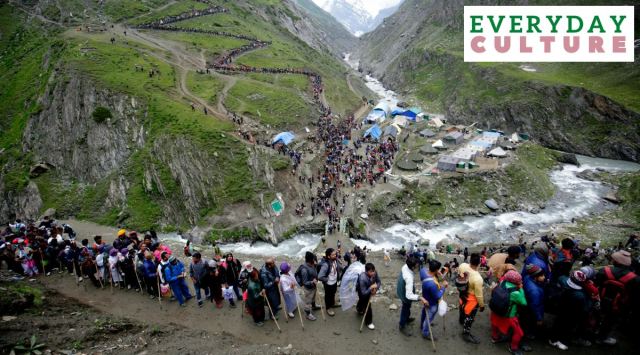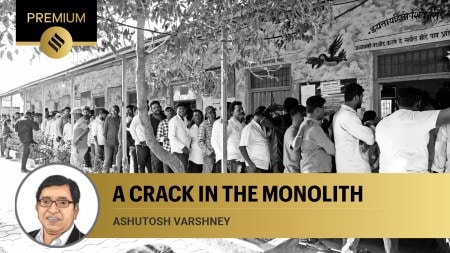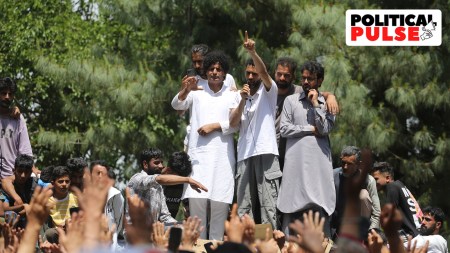- India
- International
Explained: Amarnath Yatra, the legend and the pilgrimage
Amarnath Yatra: The annual Amarnath Yatra to the cave shrine of Lord Shiva high up in the Himalayas is among the country's most revered pilgrimages.
 The Amarnath Yatra in 2018. (Express Photo: Praveen Khanna)
The Amarnath Yatra in 2018. (Express Photo: Praveen Khanna)After being suspended for two years due to the novel coronavirus pandemic, the 43-day Amarnath pilgrimage in the Himalayas of South Kashmir will begin on June 30 this year.
In 2021, a 56-day Yatra had been announced through both the Baltal and Chandanwari routes from June 28, but it was called off due to the rise in Covid-19 cases.
The annual Amarnath Yatra to the cave shrine of Lord Shiva high up in the Himalayas is among the country’s most revered pilgrimages. Hundreds of thousands of pilgrims make the trek up to the shrine each year. However, there is no official record of when the Yatra formally began.
Amarnath Yatra: Legend and discovery of the shrine
According to legend, when Lord Shiva decided to tell Parvati the secret of his immortality (Amar Katha), he chose the Amarnath cave deep in the Himalayas in South Kashmir. The cave is situated 3,888 metres above sea level, and can be reached only on foot or by pony. Pilgrims travel 46 km from Pahalgam or 16 km from Baltal along a steep, winding mountain trail.
According to lore, the cave was discovered by a Muslim shepherd named Buta Malik in 1850. Malik was high up in the mountains with his herd of animals, when a Sufi saint gave him a bagful of coal. After he returned home, Malik opened the bag, and found it to be full of gold. The ecstatic and overwhelmed shepherd ran to the mountains to thank the saint, but he could not find him.

What he found instead, was the cave, and its famous ice lingam.
The ice lingam, representing Lord Shiva, is formed by a trickle of water from a cleft in the roof of the cave. The water freezes as it drips, forming, over time, a tall, smooth ice stalagmite. The Shiva lingam gets its full shape in May every year, after which it begins to melt. By August, it is just a few feet in height.
On the left of the Shiva lingam are two smaller ice stalagmites, representing Parvati and Lord Ganesh.
The streamlining of the Amarnath Yatra
The family of Buta Malik remained the traditional custodian of the shrine, along with Hindu priests from the Dashnami Akhara and Purohit Sabha Mattan. This unique ensemble of faiths turned Amarnath into a symbol of Kashmir’s centuries-old communal harmony and composite culture.
In 2000, Chief Minister Farooq Abdullah’s government intervened, saying facilities for the Yatra needed to be improved. The Shri Amarnathji Shrine Board was formed with the Governor at its head, and Malik’s family and the Hindu organisations were evicted. This streamlined the Yatra, but also did away with one of its most unique features.
According to the Purohit Sabha Mattan, the pilgrimage was initially held for 15 days or a month. In 2005, the Shri Amarnathji Shrine Board decided to spread the pilgrimage out over nearly two months.
Threats to the Amarnath Yatra
The first security threat to the pilgrimage came in 1993, when the Pakistan-based Harkat-ul-Ansar announced a ban on the Yatra — ostensibly to protest the demolition of the Babri Masjid, and to demand the removal of bunkers at the Hazratbal shrine in Srinagar. There was widespread condemnation of the diktat, and the local militant groups did not back it. The Yatra progressed unhindered through the peak years of militancy.
In 2000, in the first direct targeting of Amarnath Yatris, 25 people, including 17 pilgrims, were killed in a militant attack on the Pahalgam base camp. Over the two years that followed, several Yatris were killed in big and small attacks.
There were no major incidents after 2002, however; even during the massive protests against the transfer of government land to the Amarnath Shrine Board in 2008, the Yatra remained unaffected. Even as the Valley and Jammu’s Hindu majority areas were sharply divided along communal lines, mohalla committees organised langars for Yatris in Srinagar and Ganderal districts.
This situation remained unchanged during the 2010 and 2016 summer uprisings. In July 2017, however, seven pilgrims were killed in a terror attack on their bus. Days later, the government told Lok Sabha that 53 pilgrims had been killed and 167 injured in 36 terror attacks on the annual Amarnath Yatra in the last 27 years since 1990.
Newsletter | Click to get the day’s best explainers in your inbox
More Explained
Must Read
EXPRESS OPINION
May 20: Latest News
- 01
- 02
- 03
- 04
- 05








































